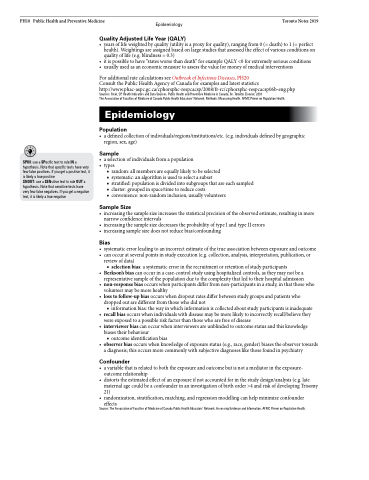Page 1228 - TNFlipTest
P. 1228
PH10 Public Health and Preventive Medicine Epidemiology Toronto Notes 2019
Quality Adjusted Life Year (QALY)
• yearsoflifeweightedbyquality(utilityisaproxyforquality),rangingfrom0(=death)to1(=perfect health). Weightings are assigned based on large studies that assessed the effect of various conditions on quality of life (e.g. blindness = 0.3)
• itispossibletohave“statesworsethandeath”forexampleQALY<0forextremelyseriousconditions
• usuallyusedasaneconomicmeasuretoassessthevalueformoneyofmedicalinterventions
For additional rate calculations see Outbreak of Infectious Diseases, PH20
Consult the Public Health Agency of Canada for examples and latest statistics
http://www.phac-aspc.gc.ca/cphorsphc-respcacsp/2008/fr-rc/cphorsphc-respcacsp06b-eng.php
Sources: Shah, CP. Health Indicators and Data Sources. Public Health and Preventive Medicine in Canada, 5e. Toronto: Elsevier, 2003
The Association of Faculties of Medicine of Canada Public Health Educators’ Network. Methods: Measuring Health. AFMC Primer on Population Health.
Epidemiology
Population
• adefinedcollectionofindividuals/regions/institutions/etc.(e.g.individualsdefinedbygeographic region, sex, age)
Sample
• aselectionofindividualsfromapopulation • types
■ random: all members are equally likely to be selected
■ systematic: an algorithm is used to select a subset
■ stratified: population is divided into subgroups that are each sampled ■ cluster: grouped in space/time to reduce costs
■ convenience: non-random inclusion, usually volunteers
Sample Size
• increasingthesamplesizeincreasesthestatisticalprecisionoftheobservedestimate,resultinginmore narrow confidence intervals
• increasingthesamplesizedecreasestheprobabilityoftypeIandtypeIIerrors
• increasingsamplesizedoesnotreducebias/confounding
Bias
• systematicerrorleadingtoanincorrectestimateofthetrueassociationbetweenexposureandoutcome
• canoccuratseveralpointsinstudyexecution(e.g.collection,analysis,interpretation,publication,or
review of data)
■ selectionbias:asystematicerrorintherecruitmentorretentionofstudyparticipants
• Berkson’sbiascanoccurinacase-controlstudyusinghospitalizedcontrols,astheymaynotbea representative sample of the population due to the complexity that led to their hospital admission
• non-responsebiasoccurswhenparticipantsdifferfromnon-participantsinastudy,inthatthosewho volunteer may be more healthy
• losstofollow-upbiasoccurswhendropoutratesdifferbetweenstudygroupsandpatientswho dropped out are different from those who did not
■ information bias: the way in which information is collected about study participants is inadequate
• recallbiasoccurswhenindividualswithdiseasemaybemorelikelytoincorrectlyrecall/believethey
were exposed to a possible risk factor than those who are free of disease
• interviewerbiascanoccurwheninterviewersareunblindedtooutcomestatusandthisknowledge
biases their behaviour
■ outcome identification bias
• observerbiasoccurswhenknowledgeofexposurestatus(e.g.,race,gender)biasestheobservertowards a diagnosis; this occurs more commonly with subjective diagnoses like those found in psychiatry
Confounder
• avariablethatisrelatedtoboththeexposureandoutcomebutisnotamediatorintheexposure- outcome relationship
• distortstheestimatedeffectofanexposureifnotaccountedforinthestudydesign/analysis(e.g.late maternal age could be a confounder in an investigation of birth order >4 and risk of developing Trisomy 21)
• randomization,stratification,matching,andregressionmodellingcanhelpminimizeconfounder
effects
Source: The Association of Faculties of Medicine of Canada Public Health Educators’ Network. Assessing Evidence and Information. AFMC Primer on Population Health.
SPIN: use a SPecific test to rule IN a hypothesis. Note that specific tests have very few false positives. If you get a positive test, it is likely a true positive
SNOUT: use a SENsitive test to rule OUT a hypothesis. Note that sensitive tests have very few false negatives. If you get a negative test, it is likely a true negative


